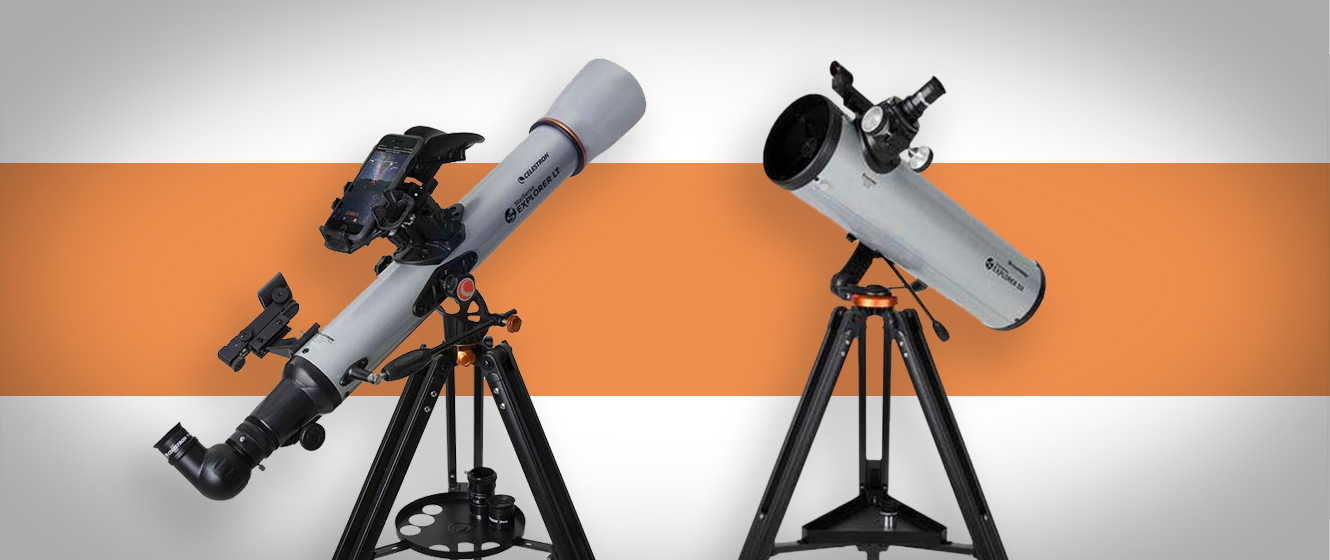
The Celestron StarSense Explorer is a fantastic series of newtonians and refractors produced by Celestron. These telescopes are designed mainly for beginners and are quick-and-easy to set up in under five minutes in your backyard. The StarSense DX series consists of four different telescopes: the LT 80AZ, LT 114AZ, DX 102AZ, and the DX 130AZ. For more information about the differences between a reflector and a refractor telescope, we recommend checking out our Beginners Guide to Reflector Telescopes and our Beginners Guide to Refractor Telescopes. This article will be a general overview of this fantastic, easy-to-use series of telescopes designed for beginners looking to quickly get out under the stars.
An Awesome Experience
Benefits of Using the Celestron StarSense Explorer
The Celestron StarSense Explorer DX series of telescopes uses your smartphone to align with the night sky. From here, the dedicated StarSense Explorer app will look at the stars as seen through your smartphone’s camera and compare it with its database of stars. Then, it will look at the current time and automatically align itself with the night sky. The app can be downloaded either from the Apple Store or Google Play. This method is not dissimilar to the method used by advanced astrophotographers called “platesolving”. This makes alignment an incredibly simple and easy process. Additionally, after you’re done aligning the mount via the app, you can remove your smartphone from the phone dock and the mount will continue to know where it’s pointed.
Overview of the Celestron StarSense Explorer LT 80AZ

The first (and smallest) telescope of this series is the Celestron StarSense Explorer LT 80AZ. Although this telescope has 80mm of aperture, representing a 78% increase in light-gathering capability over the Celestron StarSense Explorer LT 60AZ refractor, it also has an impressive focal length of 900mm at f/11. The long focal length will greatly help to cut down on color distortions found in refractors that have a shorter focal length. Included is a 10mm and 25mm eyepiece. With these two eyepieces, you will be able to achieve a magnification of 90x and 36x respectively. The 10mm eyepiece is great for planetary observing, and you will easily be able to observe the moons of Jupiter, polar ice caps on Mars, the rings of Saturn (as well as Saturn’s moon, Titan), the phases of Venus, and more. The 25mm eyepiece is sufficient to observe the Moon and brighter deep-sky objects like the Orion Nebula and the Andromeda Galaxy. Also included is a 2x Barlow, which will change the focal length of the telescope from 900mm to 1800mm and boost the magnification with the 10mm eyepiece from 90x to 180x, improving your ability to look further into the cosmos. A 90 degree diagonal is also included.
For more accessories, we recommend checking out our Celestron StarSense Explorer LT 80AZ Essential Bundle. You also receive a 1.25” Apertura Moon Filter. This is incredibly useful for observing the Moon, as you’ll be able to cut down on the intense glare on the lunar surface & see more contrast in your views. Additionally, the Essential Bundle Package includes the Apertura Cleaning Kit to ensure that the inevitable dust and grime can be cleaned off your lens or eyepieces. Lastly, also included is a red LED flashlight to help you find your way in the dark without ruining your night adjusted vision.

A simulated view of the Moon as seen through the Celestron StarSense Explorer LT 80AZ and 25mm eyepiece. You will easily be able to spot major craters such as Tycho, Copernicus, and countless more. Credit: Astronomy.tools
Overview of the Celestron StarSense Explorer LT 114AZ
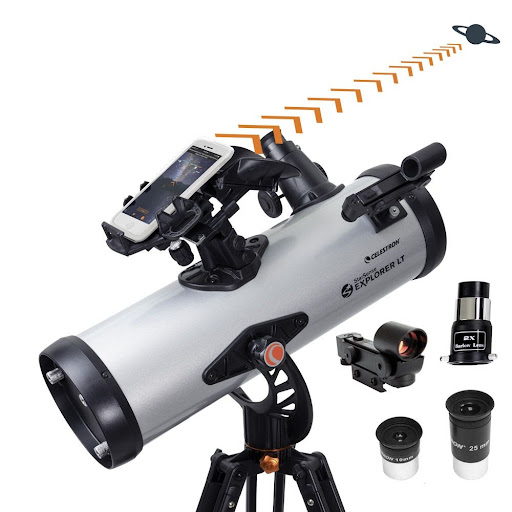
The Celestron StarSense Explorer LT 114AZ is the newtonian counterpart to the LT 80AZ. This telescope is a “Bird-Jones'' reflector with a 114mm (4.5”) aperture and 1,000mm focal length.This optical design provides a longer focal length which allows for an inherently higher magnification with the included eyepieces. All in a fairly short optical tube. For more information on how reflector telescopes work, we again recommend our Beginners Guide to Reflector Telescopes. With the included 10mm and 25mm eyepieces, you’ll be able to push your magnification to 100x and 40x respectively. With the 10mm eyepiece, you’ll be easily able to - like the LT80AZ - observe the rings of Saturn, the moons of Jupiter, the Great Red Spot, and much more. With the 25mm eyepiece, you’ll perfectly be able to frame up the Andromeda Galaxy, as well as observe the Orion Nebula, Lagoon Nebula, Trifid Nebula, and more. For more accessories, we also recommend the StarSense Explorer LT 114AZ Essential Bundle package.
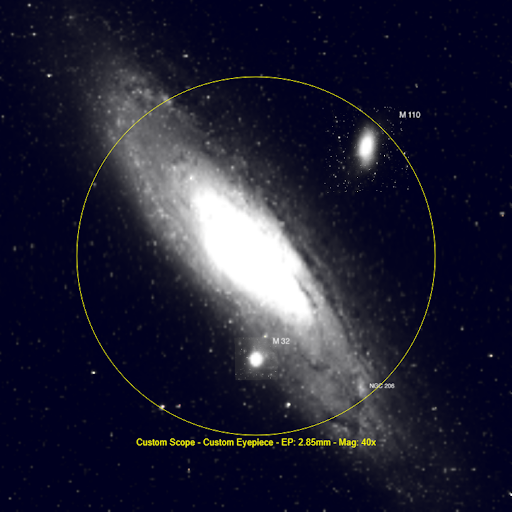
Simulated view through the 25mm eyepiece of the Celestron StarSense Explorer LT114AZ. Please note that the brightness of the Andromeda Galaxy has been enhanced through multiple exposures and is not representative of how it will appear in the eyepiece. This image is just to give an example of framing. Credit: Astronomy.tools
Overview of the Celestron StarSense Explorer DX 102AZ
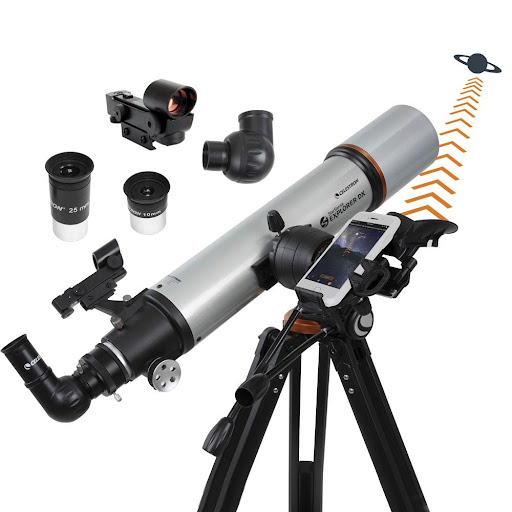
The Celestron StarSense Explorer DX 102AZ is the largest refractor sold in the StarSense Explorer series. This telescope represents a 65% increase in light gathering capability over the LT 80AZ with a shorter focal length, making it a fantastic refractor to observe deep sky objects. It features a 102mm (4”) f/6.5 achromatic lens. This yields a focal length of 663mm. With the included 25mm and 10mm eyepieces, you will be able to achieve a magnification of 26x and 66x respectively. The Celestron StarSense Explorer DX 102AZ optical tube assembly (OTA) also comes with a dovetail bar that can be used on other mounts.
What can I see with this telescope?
With this telescope, you will easily be able to spot an incredible variety of nebulae and galaxies. With the included 25mm lens, you will be able to spot the Orion Nebula, Andromeda Galaxy, the Bode and Cigar Galaxy in Ursa Major, the Pleiades, the Lagoon Nebula, and many more bright deep sky objects with a large apparent size in the night sky. With the 10mm eyepiece, you will be able to easily see the cloud belts and moons of the planet Jupiter, craters on the surface of the Moon in stunning detail, and the beautiful rings of Saturn (as well as a few moons, such as Titan and Rhea). All of this while not stressing about alignment thanks to the StarSense app’s platesolving technology.
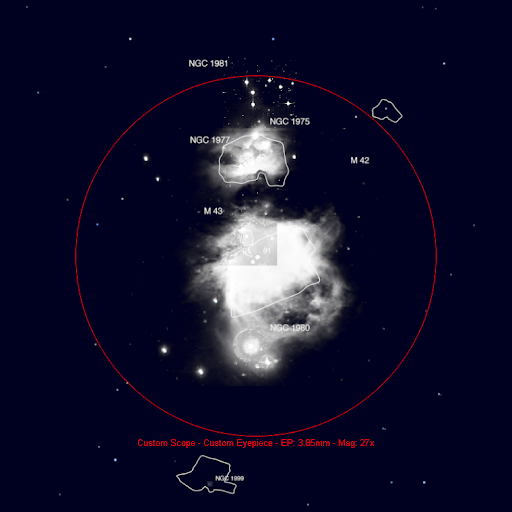
Simulated view of the field of view with a 25mm eyepiece. Please note that the Orion Nebula will not appear this bright in your image. Credit: Astronomy.tools
While the 4 inches of unobstructed aperture of the 102DX provide a considerable amount of contrast and overall brightness, the achromatic lens assembly will provide a bit of chromatic aberration (slight color casting) around the brightest of objects in the night sky. This will not impact your views of deep sky objects as they are faint by nature but may be slightly visible on planets and the moon. That being said, using a refractor has one significant advantage over the 130AZ reflector in that you do not have to worry about collimation or the mirror cooling down. With the 102mm, all you have to do is setup and enjoy. As with the LT80AZ and LT114AZ, you can also find additional accessories for this telescope in the Essential Bundle Package.
Recommended Accessories for the DX 102AZ
- Apertura Smartphone Adapter - If you are interested in taking photos of the planets and lunar surface - you may try to attach your smartphone camera to your eyepiece with the Apertura Smartphone Adapter. Please note that removing the phone from the celestron smartphone adapter and switching it to your camera app will NOT lose your alignment as long as the scope hasn't been moved. However, you will have to follow the steps in the smartphone app to quickly resync your telescope mount with the night sky.
- Apertura 2X Barlow Lens - To resolve more detail on the planets, it’s recommended you purchase a Barlow lens. A Barlow lens works by increasing the focal length of the telescope by a factor of 2x, 3x, et cetera. The Apertura 2x Barlow will increase the focal length from 663mm to 1326mm, which yields a much more impressive 133x magnification. However, anticipate that it might be harder to center planets with this magnification & that planets will appear dimmer as you increase magnification.
Overview of the Celestron StarSense Explorer DX 130AZ
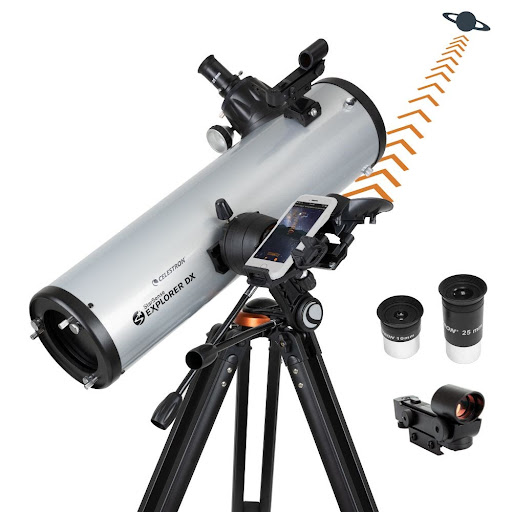
The Celestron StarSense Explorer DX 130AZ is the newtonian counterpart of the DX series. This telescope comes with a 130mm (5.1”) f/5 reflecting mirror, resulting in a nearly 28% increase in light gathering capability over the LT114AZ. The telescope comes with a focal length of 650mm, making it a fantastic option for deep sky observing. Also included are the same eyepieces as with the DX 102 AZ, which yield a magnification of 26x and 65x. Like the DX 102AZ, additional accessories are included in the Essential Bundle Package. Included is the same 1.25” moon filter, red LED, and Apertura Cleaning Kit.
What can I see with this telescope?
The Celestron StarSense Explorer DX 130AZ features a slightly larger (5” vs 4”) primary objective, which will result in slightly brighter views of objects in the night sky. You will be able to observe similar objects as with the DX 102AZ, however with greater clarity. The planets will have slightly better detail to them, and you should easily be able to observe the two main cloud belts on Jupiter, the rings of Saturn, and much more.
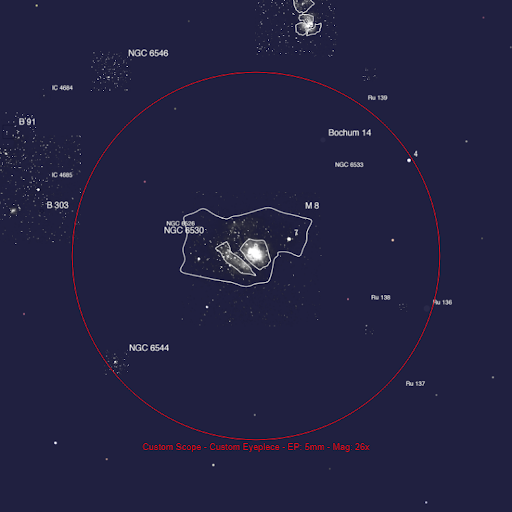
Simulated view of the Lagoon Nebula through the DX 130AZ. This is with the 25mm eyepiece yielding an approximate magnification of 26x. Credit: Astronomy.tools
Recommended Accessories for the DX 130AZ
- Apertura Smartphone Adapter - If you are interested in taking photos of the planets and lunar surface - you may try to attach your smartphone camera to your eyepiece with the Apertura Smartphone Adapter. Please note that removing the phone from the celestron smartphone adapter and switching it to your camera app will NOT lose your alignment as long as the scope hasn't been moved.
- 2” Eyepieces - The DX130AZ reflector focuser also comes with the ability to install a 2” eyepiece directly into your focuser. A 2” eyepiece will enable you to have a wider field of view, a larger eye relief, and experience more of the “in space” feeling a telescope can bring. Examples of these eyepieces include the 2 inch Apertura 32mm or Apertura 26mm SWA eyepieces. Both of these eyepieces are fantastic, high-quality eyepieces that will greatly increase both the depth and clarity of your views of nebulae and galaxies.
- Apertura 2X Barlow Lens - To resolve more detail on the planets with the included eyepieces, it’s recommended you purchase a Barlow lens. A Barlow lens works by increasing the focal length of the telescope by a factor of 2x, 3x, et cetera. The Apertura 2x Barlow will increase the focal length from 650mm to 1300mm, which yields a much more impressive 130x magnification with the 10mm eyepiece. However, anticipate that it might be harder to center planets with this magnification & that planets will appear dimmer as you increase magnification. The amount of detail you are able to resolve is highly dependent on the accuracy of your collimation with this telescope.
- Laser Collimator - For the quickest and most accurate collimation, we recommend a laser collimator to align the primary and secondary mirrors. The Apertura 1.25” Laser Collimator or the Hotech 1.25” SCA Dot Laser Collimator are both great choices for this telescope.
Overview Of The Celestron StarSense 8” Dobsonian
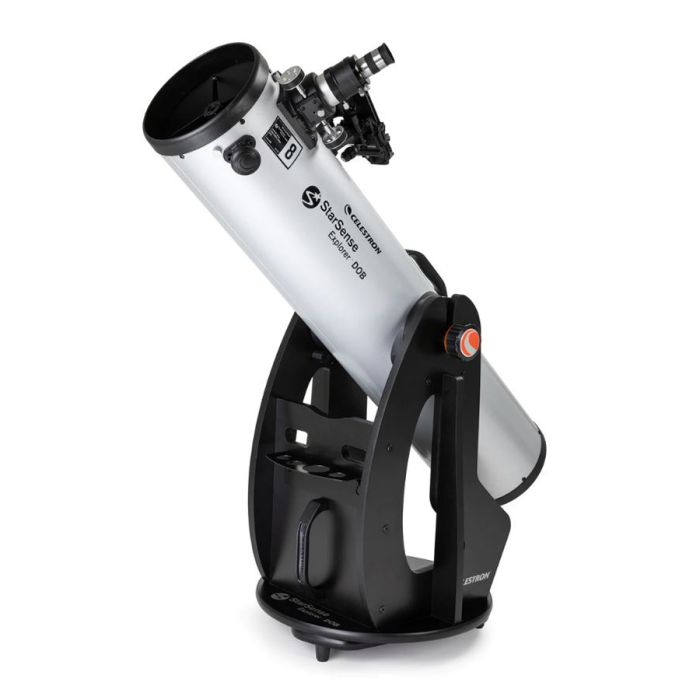
The Celestron StarSense Explorer 8" Dobsonian telescope is a powerful and user-friendly instrument designed to bring the wonders of the night sky within reach of both beginners and experienced stargazers. Its 8” aperture represents the perfect middle-ground Dobsonian in the lineup of Celestron’s new StarSense Explorer telescopes – not too small, but large enough to capture faint galaxies and planets while being portable enough to easily take outside.
Utilizing innovative StarSense sky recognition technology, this telescope eliminates the need for prior telescope experience. Simply connect your smartphone to the StarSense Explorer Powered by SkySafari app, and the patented technology will analyze the star patterns above, accurately calculating the telescope's position in real time.
With its large 8” parabolic primary mirror featuring XLT coatings, the telescope offers exceptional light-gathering capabilities, enabling users to locate and observe faint, deep-sky objects with ease. Experience celestial objects in breathtaking detail like never before. Additionally, this telescope gathers over 240% more light than the StarSense Explorer DX130 AZ and similar-sized telescopes.
The telescope's sturdy Dobsonian-style base boasts large diameter bearings and variable altitude tensioning, making it effortless to follow the on-screen arrows leading to your desired target. Once the bullseye turns green on the app, you're ready to view the celestial wonder through the telescope's eyepiece.
The package includes a 25mm Plössl eyepiece offering a magnification of 48x normal human vision, a 2” Crayford focuser for smooth and precise focusing, the StarSense smartphone dock for seamless connectivity, a StarPointer red dot finderscope for easy object targeting, an eyepiece rack for convenience, and a collimation tool for accurate alignment of the primary and secondary mirrors.
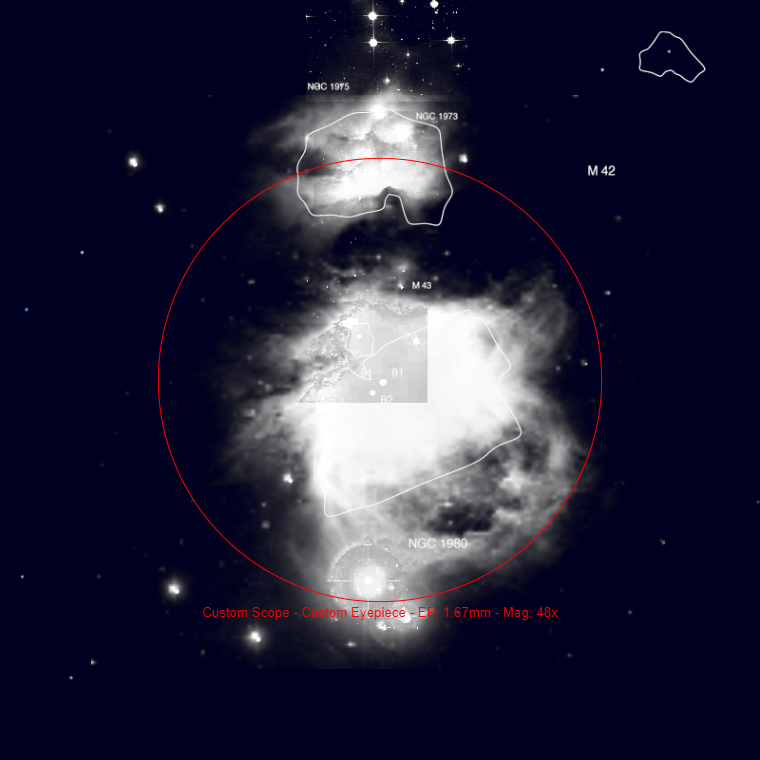
A simulated view as seen through the 25mm lens and 8” aperture, representing roughly 48x normal human vision - credit: Astronomy.tools. Again please note that the brightness of the Orion Nebula has been enhanced through multiple exposures and is not representative of how it will appear in the eyepiece. This image is just to give an example of framing.
Overview Of The Celestron StarSense 10” Dobsonian
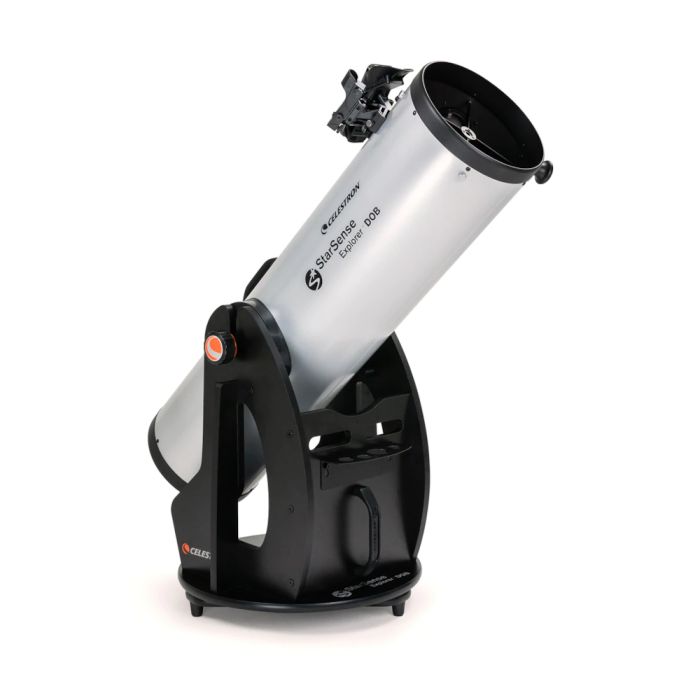
The Celestron StarSense 10" reflector telescope is the bigger brother to the 8” StarSense. It’s a powerful, highly capable telescope designed for exceptional astronomical observations. Its 10-inch aperture provides significantly enhanced light-gathering capability compared to the StarSense 8" model, making it approximately 1,317 times more powerful than the human eye in capturing celestial light. This substantial increase in light gathering allows for clearer and more detailed views of distant and faint objects in the night sky, unveiling breathtaking sights that would be challenging to observe with smaller telescopes, including the smaller 8” reflector.
Despite weighing more than the 8" model, the StarSense 10" reflector telescope justifies its weight with the stunning views it offers. The optical design features a Newtonian reflector, with a focal length of 1200mm and a focal ratio of f/4.7. Accompanied by the included 25mm eyepiece, users can achieve a magnification of 48x – exactly the same as with the 8”, but with 1.56x more light-gathering capability. Additionally, the telescope's highest useful magnification reaches 600x, enabling astronomers to explore planetary details and other celestial features with impressive clarity. Moreover, the telescope's optical coatings, XLT reflective coatings with protective over coatings, and the quality Pyrex equivalent mirror material ensure optimal image brightness and clarity during observation.
To really push this telescope to its limits, we recommend purchasing a Barlow lens, like the Celestron X-Cel LX 3X 1.25” eyepiece. This will change your magnification with the 25mm lens from 48x to 144x – effectively turning this telescope into one dedicated to planetary observations. Use the 25mm lens to center your target like Saturn and Jupiter, then simply put the Barlow lens into the eyepiece holder & the 25mm onto the eyepiece. You’ll be treated to breathtaking views of Saturn, Jupiter, Uranus, Neptune, and even split double and triple stars!
Overview Of The Celestron StarSense 12” Dobsonian
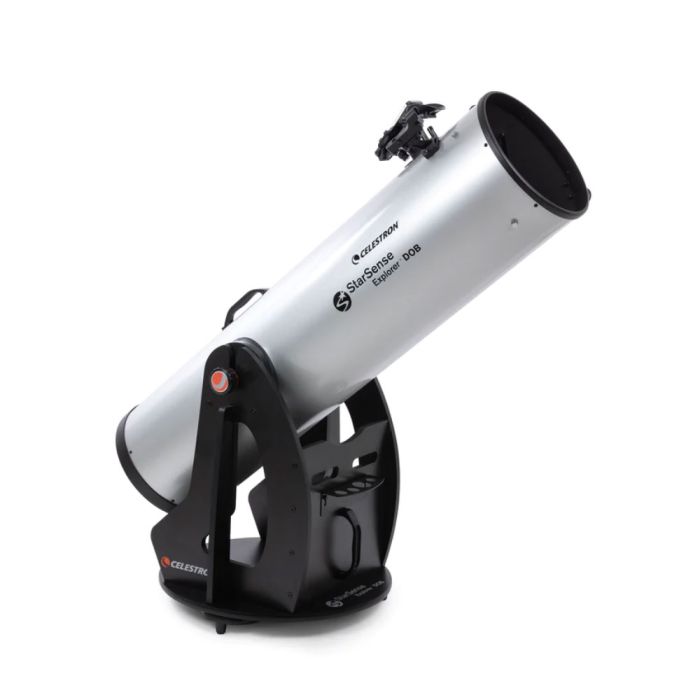
The Celestron StarSense 12” Dobsonian Telescope is the ultimate StarSense telescope in terms of size and light-gathering capability. This massive telescope represents a 2.25x increase in light-gathering capability over the 8” StarSense, bringing details to distant galaxies and nebulas that cannot be seen in smaller telescopes, while still retaining a degree of portability inherent to other Dobsonians. However, make no mistake – this is a very large telescope. The optical tube assembly weighs 49.8 lbs and the base 33 lbs, making the two a very heavy combination. The optical tube assembly (OTA) comes with a handlebar, and the mount design makes the two relatively easy to set up in your backyard provided you move the two separately.
The optical design of this telescope is a Newtonian Reflector with a 305mm (12") aperture and a focal length of 1500mm (59"), resulting in a focal ratio of f/4.9. It comes with a 32mm (1.26") eyepiece providing a magnification of 47x, and the highest useful magnification is 720x, while the lowest is 43x. The telescope's light-gathering power is 1895 times greater than that of the human eye, with a limiting stellar magnitude of 14.9. The optical coatings consist of XLT reflective coatings with protective over coatings for the primary and secondary mirrors, which are made from Pyrex equivalent material. Additionally, the telescope features a 2" Crayford focuser with additional adapters and a StarPointer red-dot finderscope.
Overview Of The Celestron StarSense Explorer 114mm Tabletop Dobsonian

This telescope is the smallest Dobsonian telescope in Celestron’s StarSense line-up! The StarSense Explorer 114mm Tabletop Dobsonian features all of the functionality of the larger 8” telescopes in a smaller, more portable package. With an aperture of 114mm (4.48”) and a focal length of just 450mm (17.71”), this telescope is great for scanning the Milky Way for deep-sky objects.
StarSense Explorer revolutionizes stargazing by simplifying celestial navigation through its user-friendly app and unique phone dock. Setting up the telescope is quick and easy, and after aligning the phone to the optics, the app generates a list of visible celestial objects. On-screen arrows guide the telescope's movements until the target appears in the eyepiece, indicated by a green bullseye.
The stable Tabletop Dobsonian base with Teflon bearings ensures smooth motion and easy tracking. Its low profile facilitates access to the eyepiece, and an optional tripod provides more viewing options. Weighing just 4.2 lbs, this telescope and mount combination can easily sit on any flat surface (thus the name “tabletop”) and is the perfect choice for a portable, deep sky scanning telescope that will deliver beautiful views on your next dark sky trip!
With this telescope and the included 17mm eyepiece, producing a magnification of 26x human vision, you’ll be able to see the beautiful Andromeda Galaxy, the Orion Nebula, and the Lagoon Nebula! This telescope would be an absolutely perfect choice for bringing out to your nearest dark sky site and being swarmed with a sea of stars, scanning the constellations of Cygnus and Sagittarius in the Summer, or viewing the belt of Orion in the winter time.
Additionally, the included 10mm eyepiece will increase your magnification from 26x to 45x, giving you a glimpse of the craters on the Moon, as well as the moons of Jupiter and the rings of Saturn!
Overview Of The Celestron StarSense Explorer 130mm Tabletop Dobsonian
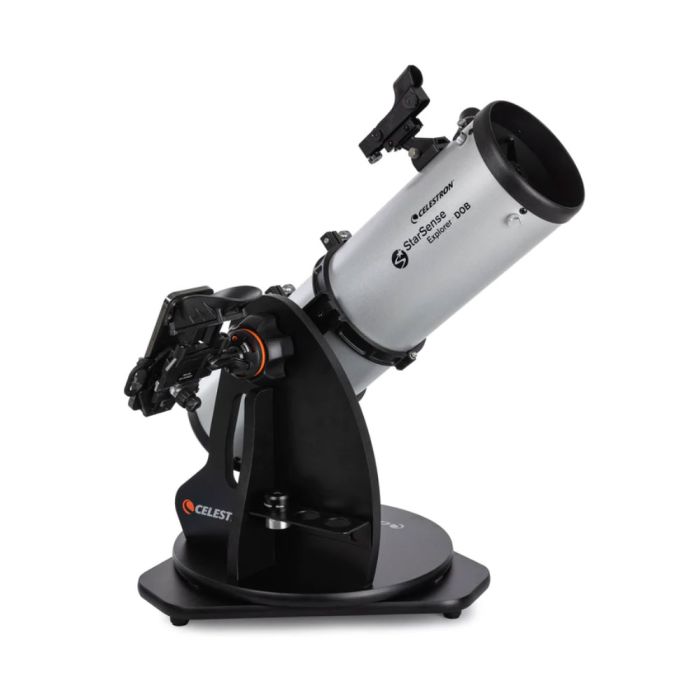
The Celestron StarSense Explorer 130mm telescope is a great compromise between the 114mm tabletop and 150mm tabletop telescopes. With 130mm (5.1”) of aperture, you’ll be treated with enough light-gathering capability to see hints of the cloud belts on Jupiter, the Great Red Spot, the Rings of Saturn, sprawling views of the Pleiades, and the Great Orion Nebula.
By placing your phone in the StarSense dock and using the app, you can easily navigate the sky and locate celestial objects. The app aligns with the telescope's optics, generating a list of visible objects. Arrows on the screen guide you to move the telescope, and a green bullseye indicates when the object is ready to view in the eyepiece. The app also offers audio descriptions and detailed information about thousands of celestial objects in its database.
While a little heavier than its little brother, this tabletop Dobsonian still only weighs only as much as a large watermelon, with a gross weight of 19.2 lbs. It has a focal length of 650mm, and combined with its 130mm aperture, produces a magnification of 26x and 65x normal human vision. This telescope would be ideal for bringing with you on your next camping trip to see the stars!
Overview Of The Celestron StarSense Explorer 150mm Tabletop Dobsonian
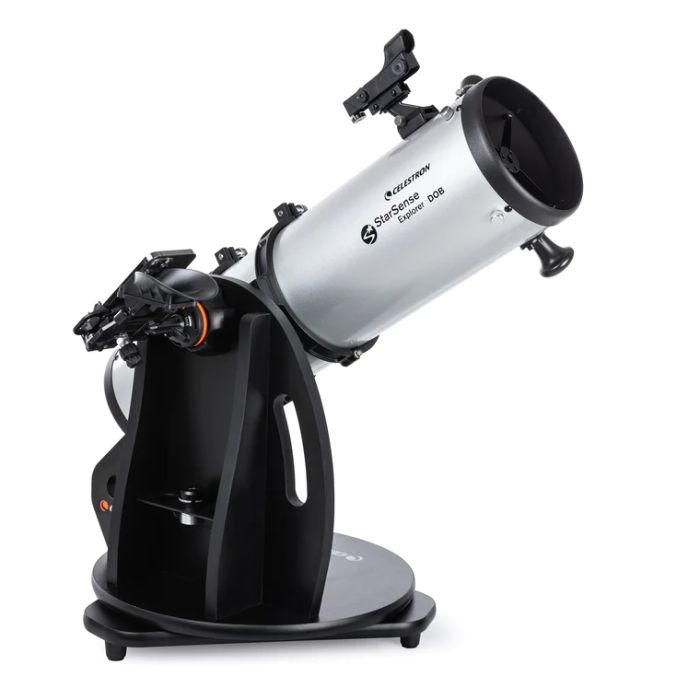
The Celestron StarSense Explorer 150mm Tabletop Dobsonian telescope is the largest of the tabletop Dobsonians on this list. The telescope boasts a 150mm (5.9”) aperture parabolic primary mirror, enabling impressive light-gathering capabilities for detailed views of various celestial objects. Expect clear, sharp images of Jupiter's moons, cloud bands, and Great Red Spot, Saturn's rings, the Orion Nebula's trapezium, and the Pleiades Open Star Cluster. Additionally, the telescope's optics allow for viewing subtle details on the Moon, planets, galaxies, and nebulae. The telescope features a 1.25” rack-and-pinion focuser compatible with 1.25” eyepieces and includes dust covers for protection, similar to the smaller 114mm and 130mm telescopes. While this telescope is the heaviest in the tabletop line-up, coming in at 25 lbs fully assembled, it is an attractive option for those looking for something smaller than the StarSense 8” Dobsonian while still having considerable light-gathering capability.
Designed for beginners, the telescope's app provides a user-friendly interface with tutorials, acting as a personal tour guide for navigating the night sky. Setting up the telescope is simple—place your smartphone in the StarSense dock, align it with the telescope's optics, and the app generates a list of visible celestial objects. Arrows guide the telescope to the selected object, and when it's ready to view, the bullseye turns green. The app also offers audio descriptions and detailed information about thousands of objects!
Click the arrow above to see MLA, APA, and Chicago Manual of Style citations.
MLA:
Denny, Kyle. "Celestron Starsense Explorer Series Overview," AstronomyHub, High Point Scientific, 2 Aug. 2023, https://www.highpointscientific.com/astronomy-hub/post/celestron-starsense-explorer-overview.
APA:
Denny, K. (2023, August 2). Celestron starsense explorer series overview. High Point Scientific. https://www.highpointscientific.com/astronomy-hub/post/celestron-starsense-explorer-overview
Chicago Manual of Style:
Bibliography:
Kyle Denny. "Celestron Starsense Explorer Series Overview," AstronomyHub (blog), High Point Scientific, August 2, 2023. https://www.highpointscientific.com/astronomy-hub/post/celestron-starsense-explorer-overview.
Footnote:
Kyle Denny, "Celestron Starsense Explorer Series Overview," AstronomyHub, High Point Scientific, August 2, 2023, https://www.highpointscientific.com/astronomy-hub/post/celestron-starsense-explorer-overview.
This Article was Last Updated on 08/2/2023











